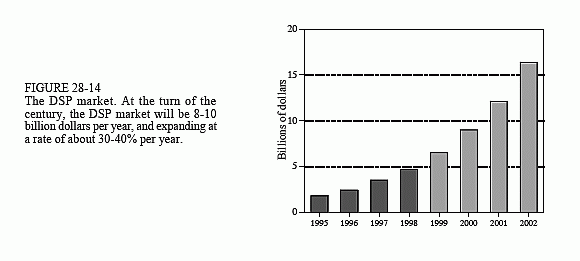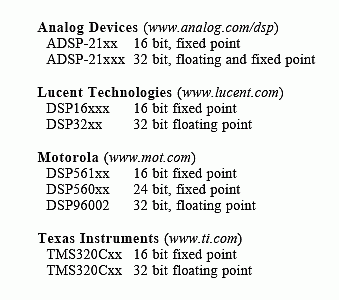The Scientist and Engineer's Guide to
Digital Signal Processing
By Steven W. Smith, Ph.D.
Book Search
Table of contents
- 1: The Breadth and Depth of DSP
- 2: Statistics, Probability and Noise
- 3: ADC and DAC
- 4: DSP Software
- 5: Linear Systems
- 6: Convolution
- 7: Properties of Convolution
- 8: The Discrete Fourier Transform
- 9: Applications of the DFT
- 10: Fourier Transform Properties
- 11: Fourier Transform Pairs
- 12: The Fast Fourier Transform
- 13: Continuous Signal Processing
- 14: Introduction to Digital Filters
- 15: Moving Average Filters
- 16: Windowed-Sinc Filters
- 17: Custom Filters
- 18: FFT Convolution
- 19: Recursive Filters
- 20: Chebyshev Filters
- 21: Filter Comparison
- 22: Audio Processing
- 23: Image Formation & Display
- 24: Linear Image Processing
- 25: Special Imaging Techniques
- 26: Neural Networks (and more!)
- 27: Data Compression
- 28: Digital Signal Processors
- 29: Getting Started with DSPs
- 30: Complex Numbers
- 31: The Complex Fourier Transform
- 32: The Laplace Transform
- 33: The z-Transform
- 34: Explaining Benford's Law
How to order your own hardcover copy
Wouldn't you rather have a bound book instead of 640 loose pages?Your laser printer will thank you!
Order from Amazon.com.
Chapter 28: Digital Signal Processors
The DSP market is very large and growing rapidly. As shown in Fig. 28-14, it will be about 8-10 billion dollars/year at the turn of the century, and growing at a rate of 30-40% each year. This is being fueled by the incessant

demand for better and cheaper consumer products, such as: cellular telephones, multimedia computers, and high-fidelity music reproduction. These high-revenue applications are shaping the field, while less profitable areas, such as scientific instrumentation, are just riding the wave of technology.
DSPs can be purchased in three forms, as a core, as a processor, and as a board level product. In DSP, the term "core" refers to the section of the processor where the key tasks are carried out, including the data registers, multiplier, ALU, address generator, and program sequencer. A complete processor requires combining the core with memory and interfaces to the outside world. While the core and these peripheral sections are designed separately, they will be fabricated on the same piece of silicon, making the processor a single integrated circuit.
Suppose you build cellular telephones and want to include a DSP in the design. You will probably want to purchase the DSP as a processor, that is, an integrated circuit ("chip") that contains the core, memory and other internal features. For instance, the SHARC ADSP-21060 comes in a "240 lead Metric PQFP" package, only 35×35×4 mm in size. To incorporate this IC in your product, you design a printed circuit board where it will be soldered in next to your other electronics. This is the most common way that DSPs are used.
Now, suppose the company you work for manufactures its own integrated circuits. In this case, you might not want the entire processor, just the design of the core. After completing the appropriate licensing agreement, you can start making chips that are highly customized to your particular application. This gives you the flexibility of selecting how much memory is included, how the chip receives and transmits data, how it is packaged, and so on. Custom devices of this type are an increasingly important segment of the DSP marketplace.
Lastly, there are several dozen companies that will sell you DSPs already mounted on a printed circuit board. These have such features as extra memory, A/D and D/A converters, EPROM sockets, multiple processors on the same board, and so on. While some of these boards are intended to be used as stand alone computers, most are configured to be plugged into a host, such as a personal computer. Companies that make these types of boards are called Third Party Developers. The best way to find them is to ask the manufacturer of the DSP you want to use. Look at the DSP manufacturer's website; if you don't find a list there, send them an e-mail. They will be more than happy to tell you who is using their products and how to contact them.
The present day Digital Signal Processor market (1998) is dominated by four companies. Here is a list, and the general scheme they use for numbering their products:

Keep in mind that the distinction between DSPs and other microprocessors is not always a clear line. For instance, look at how Intel describes the MMX technology addition to its Pentium processor:
"Intel engineers have added 57 powerful new instructions specifically designed to manipulate and process video, audio and graphical data efficiently. These instructions are oriented to the highly parallel, repetitive sequences often found in multimedia operations."
In the future, we will undoubtedly see more DSP-like functions merged into traditional microprocessors and microcontrollers. The internet and other multimedia applications are a strong driving force for these changes. These applications are expanding so rapidly, in twenty years it is very possible that the Digital Signal Processor may be the "traditional" microprocessor.
How do you keep up with this rapidly changing field? The best way is to read trade journals that cover the DSP market, such as EDN (Electronic Design News, www.ednmag.com), and ECN (Electronic Component News, www.ecnmag.com). These are distributed free, and contain up-to-date information on what is available and where the industry is going. Trade journals are a "must-read" for anyone serious about the field. You will also want to be on the mailing list of several DSP manufacturers. This will allow you to receive new product announcements, pricing information, and special offers (such as free software and low-cost evaluation kits). Some manufacturers also distribute periodic newsletters. For instance, Analog Devices publishes Analog Dialogue four times a year, containing articles and information on current topics in signal processing. All of these resources, and much more, can be contacted over the internet. Start by exploring the manufacturers' websites, and then sending them e-mail requesting specific information.
